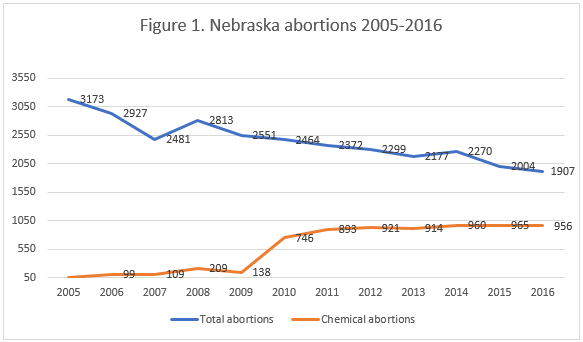Abortion Reporting: Nebraska (2016)
Nebraska’s 2016 abortion report shows that abortion totals in the state continue to fall. The 16-page report is published every May by the Nebraska Department of Health and Human Services and made available on the health department’s website.
Changes in Nebraska abortions 2015-2016

Abortion Totals and Trends
Since 2000, the earliest reporting year available, Nebraska abortions have declined 54 percent. The 2016 total of 1,907 abortions performed in the state represents a drop of almost five percent from 2015, when there were 2,004 reported abortions. Chemical abortions also fell by less than one percent from 2015. Overall, however, chemical abortions have been on the rise, with this method of abortion increasing 1,775 percent from 2000. In 2016, a total of 956 chemical abortions were performed, composing slightly more than 50 percent of the state total (Fig. 1). Nebraska does not include the state abortion rate in its reports.
State Report Summary
In 2016, eighty-nine percent of Nebraska abortions were performed on state residents. Fifty-nine percent of women seeking abortions were in their twenties. The majority of women, 63 percent, were white. Forty-seven percent reported that high school was the highest level of education they had finished. Over three-quarters of the women who had abortions had never been married. Sixty-five percent had never had a previous abortion. Most abortions were not reported to have complications*, although one resulted in a hemorrhage and another led to an unspecified complication. Almost all abortions, 91 percent, were performed at or before 12 weeks of gestation.
Nebraska prohibits abortions after 20 weeks post-fertilization, or approximately 22 weeks of gestation, except in the case of a medical emergency. No abortions after 20 weeks post-fertilization were reported in 2016. Nebraska mandates parental consent before a minor can get an abortion. In 2016, there were 62 abortions that required this consent; however, consent was only obtained in 58 cases and exceptions were made for the remaining four. The report does not specify the basis on which the exceptions were granted. Nebraska also requires that women give informed consent before undergoing an abortion. In 2016, there were no emergency exceptions to this rule.
Nebraska asks women to share their reasons for seeking an abortion, and multiple reasons can be given. The most common reason, stated by 46 percent of women, was that no contraception was used. The second most common reason, provided by 16 percent of women, was that contraception had failed. By contrast, a little more than two percent of abortions were because of the mother’s health, while the fact that the mother’s life was in danger, the pregnancy was a result of sexual assault, or the baby had a fetal anomaly were each given as a reason one percent of the time. Only one abortion was performed because the pregnancy was caused by incest. More than a quarter of women declined to provide a reason for choosing abortion.
Characteristics of Unborn Children
While many states provide valuable information on women who seek abortion, far fewer report characteristics of their unborn children. Nebraska is one of only three states to report the weight and length of unborn babies killed by abortion. In 2016, 30 babies weighed over 200 grams (approximately seven ounces). Of those 30, two babies weighed more than 400 grams (approximately 14 ounces). Sixty-eight percent of the babies, however, are reported as “Not Measurable.” Seventy-five babies were 60 millimeters or longer (around 2.4 inches). Fifty-three percent, however, are reported as “Not Measurable.”
State Ranking
A study on state abortion reporting by the Charlotte Lozier Institute ranked Nebraska’s reporting ninth best out of the 50 states, New York City, and the District of Columbia. Nebraska releases its reports quickly and regularly, making the latest statistics available to concerned citizens and researchers. However, Nebraska could improve its reporting by adding information that other states include, such as whether women seeking abortion had used contraceptives and if so, which types. As the state already collects data on the size and weight of unborn children killed by abortion, it could also request that doctors report any evidence of fetal viability. Still, Nebraska’s quick and comprehensive abortion reports rank it among the top 10 best states for state abortion reporting.

*Statistics on abortion complications reported here represent a minimal number of deaths and complications, as this data is collected in a non-systematic and non-verifiable way. As such, this data cannot be used to calculate either an accurate abortion mortality rate, nor an accurate abortion complication rate for the state.
Click here to view reporting from:2023202220212020201920182017
Tessa Longbons is a research associate for the Charlotte Lozier Institute.























